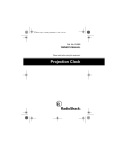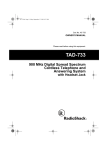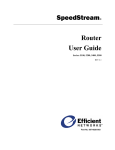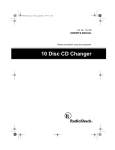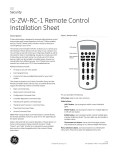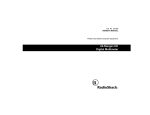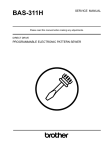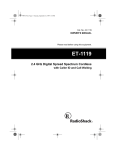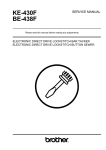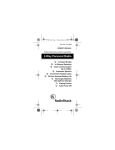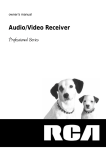Download Radio Shack 61-2677C Owner`s manual
Transcript
61-2576.fm Page 1 Wednesday, September 8, 1999 1:50 PM Cat. No. 61-2576 OWNER’S MANUAL Please read before using this equipment. Wireless Remote Control System 61-2576.fm Page 2 Wednesday, September 8, 1999 1:50 PM FEATURES With your RadioShack Plug ’N Power Wireless Remote Control System, you can discover the convenience, comfort, and security of a Plug ’N Power system. You can turn on or off all lights or appliances plugged into your Plug ’N Power Wireless Remote Control System with the touch of one button from anywhere inside or outside your home. You will never have to come home to a dark house again! Your Wireless Remote Control System includes a remote control and a control center module that lets you remotely control one light or appliance. By adding modules (not supplied), you can control up to 16 groups of lights or appliances anywhere in your home. There are several different types of modules — some plug into AC outlets and others replace wall outlets or wall switches. RadioShack carries a wide range of modules and Plug ’N Power accessories (see “Setting up Additional Modules” on Page 13 and “Adding Other Controllers” on Page 22). Because Plug ’N Power is a modular concept, you can start simply and expand your system as often as you like. With proper modules and controllers, you can remotely control practically every electrical device in your home! © 1999 Tandy Corporation. All Rights Reserved. RadioShack and Plug ‘N Power are registered trademarks used by Tandy Corporation. 2 61-2576.fm Page 3 Wednesday, September 8, 1999 1:50 PM PLUG ‘N POWER PRECAUTIONS Turning lights and appliance on and off by remote control is a great convenience, but there can be some unexpected consequences. For example, you might unknowingly turn on an empty coffee pot in another room, and it could be damaged by overheating or could even start a fire. You might also turn on an electric heater in another room when flammable materials are close to the heater. Again, damage or a fire could result. To prevent such problems, carefully plan what you want to control (as described in this manual) and keep a chart of your system handy. You must always be aware of what you are controlling. SAFETY PRECAUTIONS • Before using the product, please follow and adhere to all warnings, safety and operating instructions located on the product and in the owner's manual. Save all instructions for future use. • Do not attempt to control lights or appliances that exceed the ratings of the modules. If you want to control lights or appliances that exceed the ratings of the standard modules, see your local RadioShack store for information. 3 61-2576.fm Page 4 Wednesday, September 8, 1999 1:50 PM • Use extreme care when controlling potentially dangerous products as part of your Plug ’N Power system. Use a separate unit code exclusively for such appliances. • If you want to control fluorescent, mercury vapor, sodium, or low voltage lights, see your local RadioShack store for assistance. • Do not use Lamp Dimmer Modules to control light fixtures that have built-in dimmers. • Do not use Wall Switch or 3-Way Switch Modules to replace switches that control wall outlets or nonlighting devices. • The Wall Switch and Outlet Modules require direct connection to your house wiring. If you are not familiar with typical house wiring installation, we suggest that you have these types of modules professionally installed. In any case, be sure that the electricity is turned off at the circuit breaker or fuse panel while you are installing one of these modules. • Low-voltage electricity flows through the circuit controlled by a Wall Switch Module even when the switch is off. This is necessary for proper operation of the Wall Switch Module. You can completely turn off the electricity by sliding the switch's disable slide switch to off. 4 61-2576.fm Page 5 Wednesday, September 8, 1999 1:50 PM CONTENTS Plug ‘N Power Precautions ..................................... 3 Safety Precautions ................................................. 3 How Plug ‘N Power Works ......................................... Setting Codes ......................................................... House Code ..................................................... Unit Code ......................................................... Placing the Control Center Module ........................ Preparation ................................................................ Installing Batteries ................................................ Setting the System ............................................... Setting up Additional Modules .............................. Setting the Module Codes .................................... Connecting Lights and Appliances to Modules .... Controlling Additional Modules ............................. Dimming or Brightening Lights Connected to Modules ............................................................ Local Control of Modules ...................................... Adding Another Center ......................................... Adding Other Controllers ...................................... 6 6 7 8 9 10 10 11 13 16 17 18 20 20 21 22 Troubleshooting ........................................................ 24 Care and Maintenance .............................................. Intercom Systems ................................................. Power Interruptions .............................................. FCC Statement ..................................................... 27 28 29 30 5 61-2576.fm Page 6 Wednesday, September 8, 1999 1:50 PM HOW PLUG ‘N POWER WORKS Plug ’N Power controllers such as your Wireless Remote Control System send high frequency signals through your household wiring. The remote control sends radio frequency signals to the control system’s receiver, which retransmits the signals over your house wiring to other Plug ’N Power modules. 1 13 A 5 9 M E I 15 1 3 13 11 1 15 5 9 7 K A 5 11 9 7 UNIT C G A O E I HOUSE 3 13 UNIT O M C M E K I G HOUSE APPLIANCE MODULE Be sure to carefully read this manual and the instructions that come with the modules. They are designed to help you get the most from your Plug ’N Power system. SETTING CODES Two different types of codes — house codes and unit codes — let you control many different modules or groups of modules within your home. It is important that you understand how these codes are used before you set up your system. 6 61-2576.fm Page 7 Wednesday, September 8, 1999 1:50 PM House Code The house code is a master code for a Plug ’N Power system. You must set the remote control center mode and all the modules it controls to the same house code. There are 16 codes to choose from (A through P). O A C M K E I G You can operate two or more independent Plug ’N Power systems in your home by using a different house code for each system. Of course, each system must have its own controller and modules. You can control the same modules from two or more controllers by setting all the modules and controllers to the same house code. The different house codes also help to prevent interference between your Plug ’N Power system and other remote control systems in your neighborhood. 7 61-2576.fm Page 8 Wednesday, September 8, 1999 1:50 PM Unit Code Each Wireless Remote Control Center can operate up to 16 different modules or groups of modules. Every module has a unit code dial with settings from 1 through 16. You can set the control center to control any module or group of modules set to the same house code. 15 1 3 13 11 5 9 7 The unit code dial on the control center sets the code for the outlet on the control center. It can be set to respond to unit codes 1 through 16. However, the remote control can be set to control modules 1–8 or 9–16 by setting its slide switch accordingly. The control center will respond to all 16 unit codes and retransmit them to the Plug ’N Power modules. 8 61-2576.fm Page 9 Wednesday, September 8, 1999 1:50 PM PLACING THE CONTROL CENTER MODULE Because the control center’s module is a receiver and also a transmitter, you need to consider the best location for its installation. If you only want to use the control center module to control something plugged into it, then connect it to an outlet near the lamp or appliance you want to control. However, if you want to control other Plug ’N Power modules through the control center receiver, consider a location where it can receive the signals from the remote control more easily. Some houses have aluminum-clad insulation that might act as a barrier to radio signals, depending on where the control center module is located. You might find that you can activate the control center receiver from a greater distance if you place it in your garage, which is usually not as insulated as the rest of the house. If your house is large, you can increase the transmitting range by adding multiple Wireless Remote Control Systems. 9 61-2576.fm Page 10 Wednesday, September 8, 1999 1:50 PM PREPARATION INSTALLING BATTERIES Your remote control requires four AAA batteries (not supplied) for power. For the best performance and longest life, we recommend RadioShack alkaline batteries. Cautions: • Use only fresh batteries of the required size and recommended type. • Do not mix old and new batteries, different types of batteries (standard, alkaline, or rechargeable), or rechargeable batteries of different capacities. Follow these steps to install batteries. 1. Use your fingernail or another object to lift up the battery compartment cover to remove it. 2. Place the batteries in the compartment as indicated by the polarity symbols (+ and –) marked inside. 3. Replace the cover. When the remote control stops operating properly, replace the batteries. 10 61-2576.fm Page 11 Wednesday, September 8, 1999 1:50 PM Warning: Dispose of old batteries promptly and properly. Do not burn or bury them. Caution: If you do not plan to use the remote control for a month or more, remove the batteries. Batteries can leak chemicals that can destroy electronic parts. SETTING THE SYSTEM 1. Use a small screwdriver to set the house code dials on both the remote control and the control center receiver to the same letter. If you already own other Plug ’N Power accessories and are adding the Wireless Remote Control Center to your system, set both house codes to the same letter as the rest of your system. 2. Set 1–8/9–16 on the remote control to the desired setting. For example, if you want to control modules 1–8, set 1–8/9–16 to 1–8. 3. Plug the light or appliance to be controlled into the AC outlet on the bottom of the control center’s receiver, then plug the receiver into a standard AC outlet. 4. Be sure the light or appliance is turned on. 11 61-2576.fm Page 12 Wednesday, September 8, 1999 1:50 PM 5. Press ON/OFF on the receiver to make sure the light or appliance turns on and off. 6. If 1–8/9–16 on the remote control is set to 9–16, press the button under ON or OFF next to 1 and 9 (labeled on your remote) to turn the light or appliance on or off. 7. Use your fingernail or another object to remove the clear cover over the label on the remote, and write down the location of each Plug ’N Power module you are using with the system on the label. Then press the clear cover back onto the remote. 8. Press the button under ON next to 1 and 9 on the remote control to turn on the light or appliance plugged into the control center module. Or, press the button under OFF next to 1 and 9 on the remote control to turn off the light or appliance. So far, we have described how to control just one light or appliance that is plugged into the Wireless Remote Control Center. However, you can control up to 16 lights and appliances by using additional lamp modules, appliance modules, and wall switch modules. 12 61-2576.fm Page 13 Wednesday, September 8, 1999 1:50 PM SETTING UP ADDITIONAL MODULES The following are types of Plug ’N Power modules available from RadioShack. We include a brief description here, but be sure to read and follow the instructions that come with each module. Other types of modules are also available. If you have special Plug ’N Power needs, ask for assistance at your local RadioShack store. Appliance Modules (Cat. No. 61-2681B) — These modules have a two prong plug and are designed to control small appliances, rated up to 15 amps resistive (such as coffee pots). You can also use them to control motors up to 1/3 horsepower and lamps that do not exceed 500 watts. Universal Appliance Modules (Cat. No. 61-2684B) — These modules have the same features as the Appliance Module, but also provide connections for appliances that have 3-prong grounded plugs. You must plug these modules into 3-prong grounded AC outlets. 13 61-2576.fm Page 14 Wednesday, September 8, 1999 1:50 PM Lamp Dimmer Modules (Cat. No. 61-2682) — These modules are designed to control lamps, and you can dim the connected lamps from a Plug ’N Power controller. You can connect incandescent lamps of up to 300 watts to these modules. Lamp Dimmer Modules respond to the ALL LIGHTS ON command. Use the module only for incandescent lamps. Some devices might be damaged by the use of the dimmer circuit (even if you don't dim the module). Do not use this module with lights that have built-in dimmers. Wall Switch Modules (Cat. No. 612683C) — These modules replace an existing wall switch. You can control incandescent lighting of up to 500 watts with one of these modules, and you can also manually control the lights. Wall Switch Modules also respond to the ALL LIGHTS ON command. 14 61-2576.fm Page 15 Wednesday, September 8, 1999 1:50 PM Caution: Do not use Lamp Dimmer modules, Wall Switch Modules, or 3-Way Wall Switch Modules with fluorescent lighting. 3-Way Wall Switch Modules (RSU 11911039) — These modules are similar to Wall Switch Modules, except that they are designed to control a light that is presently controlled from two different wall switches. 3-Way Wall Switch Modules come with a companion switch to replace the second existing switch. 3-Way Wall Switch Modules respond to the ALL LIGHTS ON command and can control incandescent lighting of up to 500 watts. You also have manual control from both wall switches. Low-voltage electricity flows through the circuit controlled by a Wall Switch Module even when the switch is off. This is necessary for proper operation of the Wall Switch Module. You can completely turn off the electricity by setting the Wall Switch Module's disable switch to off (to the left). 15 61-2576.fm Page 16 Wednesday, September 8, 1999 1:50 PM Wall Outlet Modules (Cat. No. 612685) — These modules completely replace existing wall outlets, but you can only control the top outlet from a Plug ’N Power controller. The bottom outlet is always on. You can connect appliances or lamps that draw a total of up to 1800 watts to the outlet module. Because you might use the outlet module to control an appliance, these modules do not respond to the ALL LIGHTS ON command. Caution: Do not use a Wall Outlet Module to replace an outlet that is controlled by a wall switch. You will lose control of the module if the wall switch is inadvertently turned off. SETTING THE MODULE CODES Set the house code dials on all the modules you want the Wireless Remote Control System to control to the same letter as you set on the control center receiver and remote control (A through P). 16 61-2576.fm Page 17 Wednesday, September 8, 1999 1:50 PM Set the selector switch dial on the remote control to 1–8 if you want to control the lamp and appliance set from 1 to 8, or control from 9 to 16 if you set the selector switches to 9–16. CONNECTING LIGHTS AND APPLIANCES TO MODULES After setting the desired house codes and selector switch, place the supplied labels in the boxes next to the buttons on the remote control to remind you of what each button controls. Set the power switch on the light or appliance to the ON position. Then plug the light or appliance into the receiver and plug the receiver into an outlet. 17 61-2576.fm Page 18 Wednesday, September 8, 1999 1:50 PM Follow the procedure in “Controlling Additional Modules” to test each receiver module. See “Intercom Systems” on Page 28 if your system does not work properly. CONTROLLING ADDITIONAL MODULES 1. Set the remote control's slide switch to the group of 8 modules you want to control (1–8 or 9–16). For example, if you set the switch to 1–8, the buttons on the remote control will control modules set to 1 through 8. Notes: • Button 1 can also turn the receiver module on or off. • One side of the supplied label has numbers for modules 1 through 8 printed on it, and the other side has numbers for modules 9 through 16. Use the side of the label that matches your installation. 2. Install additional Plug ’N Power modules (sold separately) as desired, following the instructions included with them. 18 61-2576.fm Page 19 Wednesday, September 8, 1999 1:50 PM Caution: Be sure to turn off the power at the main circuit breaker panel before installing Wall Switch Modules or Wall Outlet Modules. 3. Set the house code dial on all your Plug ’N Power modules to the same letter as you set on the remote control module. 4. Set the unit code dial on your Plug ’N Power modules to a number between 1 and 8 (or 9 and 16 if you set the selector switches on the Remote Control to 9-16). 5. To turn the Plug ’N Power modules on or off, press the corresponding button on the remote control for modules set to that unit code. The first button on the remote control always controls the control center receiver, and all 16 buttons will control other Plug ’N Power modules set to codes 1 through 16. 19 61-2576.fm Page 20 Wednesday, September 8, 1999 1:50 PM DIMMING OR BRIGHTENING LIGHTS CONNECTED TO MODULES Turn on the module by pressing the button on the remote control that corresponds to the module's unit code. Then press or on the remote control to dim or brighten the light. Hold the button down until you see the desired brightness level. Note: Because the control center only turns a lamp/appliance on or off, you cannot use the control center receiver to dim/brighten a lamp/appliance connected to it. LOCAL CONTROL OF MODULES Even through your lights and appliances are connected to Plug ’N Power modules, you can still turn most of them on locally using their power switches. • For most products, simply turn the power switch off and back on again. • For three-way lamps, you might have to turn the lamp's switch several times before the light turns on. • You cannot manually turn on instant-on TVs or remote controlled TVs that are connected to Plug ’N Power modules. 20 61-2576.fm Page 21 Wednesday, September 8, 1999 1:50 PM • You always have manual control of Wall Switch Modules by simply using their on/off buttons. 1 13 OFF A 5 9 M E I ON ADDING ANOTHER CENTER You can also add additional remote controls (available at your local RadioShack store) to your system. For example, you could place a remote control in each room or even in your car, so you can easily turn on/off modules set to unit codes 1–16 from any location. You can also control the control center receiver and other system modules from another type of Plug ’N Power controller (see “Adding Other Controllers” on Page 22). By adding a Timer/Controller or Clock Radio/Timer to the system, you can program modules to turn on or off automatically at set times. 21 61-2576.fm Page 22 Wednesday, September 8, 1999 1:50 PM ADDING OTHER CONTROLLERS You can easily increase the size and flexibility of your Plug ’N Power system by adding more modules or other Plug ’N Power controllers. Mini Remote Control Center (Cat. No. 61-2677C D ) — lets you instantly control up to eight Plug ’N Power modules and dim lights, too. This controller also has ALL LIGHTS ON and ALL UNITS OFF controls. Keychain-Remote Light/Appliance Switch (Cat. No. 61-2663 A ) — lets you individually turn lights or appliances on or off from any location in your home. 22 61-2576.fm Page 23 Wednesday, September 8, 1999 1:50 PM Wireless Home Security System (Cat. No. 49-2551A) — lets you work with a total of 16 wireless sensor transmitters, lamp modules, motion detectors, and other accessories to customize your home security system. Programmable Control Center & Timer (Cat. No. 612470) — lets you control up to eight groups of lights or appliances anywhere in your house using Plug ’N Power modules, plus a timer you can use to pre-program events to take place while you are away. 23 61-2576.fm Page 24 Wednesday, September 8, 1999 1:50 PM TROUBLESHOOTING If your system is not working as it should, try these suggestions. Symptom The remote control does not turn the control center receiver on or off. Suggestion Make sure the red light on the remote control lights when you press a button. The batteries in the remote control might be weak. Replace the batteries. Make sure the house code dials on the remote control and control center module are set correctly. Make sure that 1-8/9-16 on the remote control is set correctly. Make sure that you have power to the AC outlet and the light or appliance is turned on. 24 61-2576.fm Page 25 Wednesday, September 8, 1999 1:50 PM Symptom Suggestion The control center module does not turn on or off using another type of Plug ’N Power controller. Try plugging the control center receiver and the other Plug ’N Power controller into the same AC outlet. If it does not work in any AC outlet even when connected to the same duplex (top and bottom) of the AC outlet, replace the control center receiver. If it works in some AC outlets but not in others, contact your local RadioShack store for help. You cannot control other Plug ’N Power modules from your remote control. Make sure the red light on the remote control lights when you press a button. The batteries in the remote control might be weak. Replace the batteries. Make sure the house code dials on the remote control and control center module are set correctly. Make sure that 1-8/9-16 on the remote control is set correctly. 25 61-2576.fm Page 26 Wednesday, September 8, 1999 1:50 PM Symptom You cannot control other Plug ’N Power modules from your remote control (continued). 26 Suggestion Make sure that you have power to the AC outlet and the light or appliance is on. Plug another Plug ’N Power controller and the modules into the same AC outlet, then try to control the modules again. If your controller is the only one you have, use an extension cord to plug the control center receiver and your other Plug ’N Power module into the same AC outlet. If the module still does not work, replace the module. 61-2576.fm Page 27 Wednesday, September 8, 1999 1:50 PM CARE AND MAINTENANCE Your RadioShack Plug ’N Power Wireless Remote Control System is an example of superior design and craftsmanship. The following suggestions will help you care for your system so it will serve you for years. Keep the system dry. If it gets wet, wipe it dry immediately. Liquids might contain minerals that can corrode the electronic circuits. Use and store the system only in normal temperature environments. Temperature extremes can shorten the life of electronic devices, damage batteries, and distort or melt plastic parts. Keep the system away from dust and dirt, which can cause premature wear of parts. Handle the system gently and carefully. Dropping it can damage circuit boards and cases and can cause the system to work improperly. Use only fresh batteries of the required size and recommended type. Batteries can leak chemicals that damage your system’s electronic parts. 27 61-2576.fm Page 28 Wednesday, September 8, 1999 1:50 PM Wipe the system with a damp cloth occasionally to keep it looking new. Do not use harsh chemicals, cleaning solvents, or strong detergents to clean the system. Modifying or tampering with the system’s internal components can cause a malfunction and might invalidate its warranty and void your FCC authorization to operate it. If your system is not performing as it should, take it to your local RadioShack store for assistance. INTERCOM SYSTEMS Intercom systems which send voice signals over existing electrical wiring may interfere with the ability to control other modules from your control center when the intercom is in use. If the intercom system has its own separate wiring, it will not cause a problem. Intercoms will not interfere with the ability to control the control center from the remote control. 28 61-2576.fm Page 29 Wednesday, September 8, 1999 1:50 PM POWER INTERRUPTIONS When the power is restored after an outage, Lamp Modules and Wall Switch Modules will normally be OFF. You can use the remote control to turn Lamp and Wall Switch modules on after a power failure. Appliance modules (including the control center receiver) have a latching relay mechanism and will stay as they were before the interruption. 29 61-2576.fm Page 30 Wednesday, September 8, 1999 1:50 PM FCC STATEMENT This equipment generates and uses radio frequency energy, and if not installed and used properly, that is, in strict accordance with the manufacturer's instructions, may cause interference to radio and television reception. It has been type tested and found to comply with the limits for remote control security devices in accordance with the specifications in sub-parts C and E of Part 15 of FCC Rules. These limits provide reasonable protection against radio and TV interference in a residential area. However, your equipment might cause TV or radio interference even when it is operating properly. To eliminate interference, you can try one or more of the following corrective measures: • reorient or relocate the receiving antenna • increase the distance between the equipment and the radio or TV • use outlets on different electrical circuits for the equipment and the radio or TV Consult your local RadioShack store if the problem still exists. You must use shielded interface cables with this equipment. 30 61-2576.fm Page 31 Wednesday, September 8, 1999 1:50 PM NOTES 31 61-2576.fm Page 32 Wednesday, September 8, 1999 1:50 PM Limited Ninety-Day Warranty This product is warranted by RadioShack against manufacturing defects in material and workmanship under normal use for ninety (90) days from the date of purchase from RadioShack company-owned stores and authorized RadioShack franchisees and dealers. EXCEPT AS PROVIDED HEREIN, RadioShack MAKES NO EXPRESS WARRANTIES AND ANY IMPLIED WARRANTIES, INCLUDING THOSE OF MERCHANTABILITY AND FITNESS FOR A PARTICULAR PURPOSE, ARE LIMITED IN DURATION TO THE DURATION OF THE WRITTEN LIMITED WARRANTIES CONTAINED HEREIN. EXCEPT AS PROVIDED HEREIN, RadioShack SHALL HAVE NO LIABILITY OR RESPONSIBILITY TO CUSTOMER OR ANY OTHER PERSON OR ENTITY WITH RESPECT TO ANY LIABILITY, LOSS OR DAMAGE CAUSED DIRECTLY OR INDIRECTLY BY USE OR PERFORMANCE OF THE PRODUCT OR ARISING OUT OF ANY BREACH OF THIS WARRANTY, INCLUDING, BUT NOT LIMITED TO, ANY DAMAGES RESULTING FROM INCONVENIENCE, LOSS OF TIME, DATA, PROPERTY, REVENUE, OR PROFIT OR ANY INDIRECT, SPECIAL, INCIDENTAL, OR CONSEQUENTIAL DAMAGES, EVEN IF RadioShack HAS BEEN ADVISED OF THE POSSIBILITY OF SUCH DAMAGES. Some states do not allow the limitations on how long an implied warranty lasts or the exclusion of incidental or consequential damages, so the above limitations or exclusions may not apply to you. In the event of a product defect during the warranty period, take the product and the RadioShack sales receipt as proof of purchase date to any RadioShack store. RadioShack will, at its option, unless otherwise provided by law: (a) correct the defect by product repair without charge for parts and labor; (b) replace the product with one of the same or similar design; or (c) refund the purchase price. All replaced parts and products, and products on which a refund is made, become the property of RadioShack. New or reconditioned parts and products may be used in the performance of warranty service. Repaired or replaced parts and products are warranted for the remainder of the original warranty period. You will be charged for repair or replacement of the product made after the expiration of the warranty period. This warranty does not cover: (a) damage or failure caused by or attributable to acts of God, abuse, accident, misuse, improper or abnormal usage, failure to follow instructions, improper installation or maintenance, alteration, lightning or other incidence of excess voltage or current; (b) any repairs other than those provided by a RadioShack Authorized Service Facility; (c) consumables such as fuses or batteries; (d) cosmetic damage; (e) transportation, shipping or insurance costs; or (f) costs of product removal, installation, set-up service adjustment or reinstallation. This warranty gives you specific legal rights, and you may also have other rights which vary from state to state. RadioShack Customer Relations, 200 Taylor Street, 6th Floor, Fort Worth, TX 76102 We Service What We Sell 09A99 04/99 Printed in China
































